Tips For Studying With ADD
Tips for studying with ADD
I have been dealing with ADD since forever. Through all those years in school I’ve learnt a few things that help me study and keep my grades good.
🌼 Have 2 things to focus on
This might sound a bit odd but you have to distract yourself a little bit. Sitting down to a book, in a complete silence won’t help at all. You’ll find something else no matter how empty the room may be. Give yourself two things to focus on instead. The first thing is studying and the second should be something that doesn’t cost you too much thinking. Here are a few ideas for your second focus:
Have something simple in your hand to roll it around (e.g. a stone)
Music with no lyrics
A piece of paper to fold
A pencil or pen to play with
A ball to throw around
A calm pet (the calm part is important, no cat chasing!)
🌼 Try to study alone
Other poeple will not only distract you but you will aslso distract them too.
🌼 Turn off your phone
🌼 Switch between the subjects often
Study one thing for some time, then other thing and then come back to the first thing. Change things up as often as your memory can take it to keep your brain intrigued.
🌼 Change study spaces
🌼 Give yourself time to stare into space blankly
🌼 Ask someone to snap you back
Ask someone to check on you and snap you back to reality in case you lose attention
🌼 Learn in as many forms as you can
Try things out (if it’s safe to do so), hear them, look at pictures.
🌼 Give yourself enough time
Don’t wait until the last minute. Give yourself as much time as you can.
I hope I helped and have a nice day!
More Posts from Queen-strawberry and Others





Tropea (Calabria, Italy)
Photos by @acriativelife on Instagram
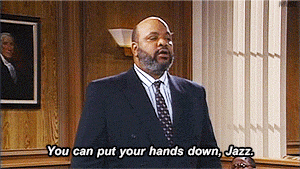
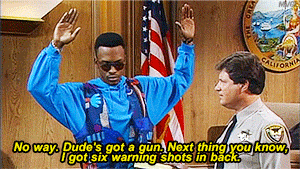

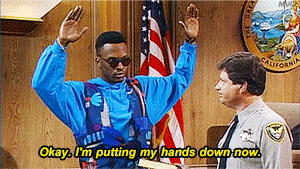
The Fresh Prince of Bel-Air 2x09 - “Cased Up” (November 11, 1991)
“All it takes is a beautiful fake smile to hide an injured soul and they will never notice how broken you really are."
- Robin Williams

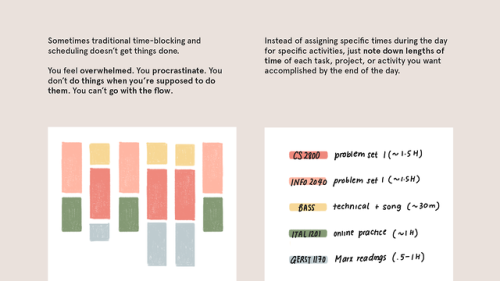


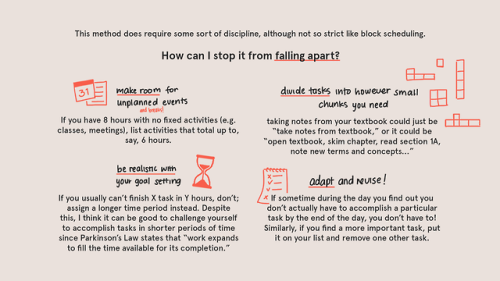
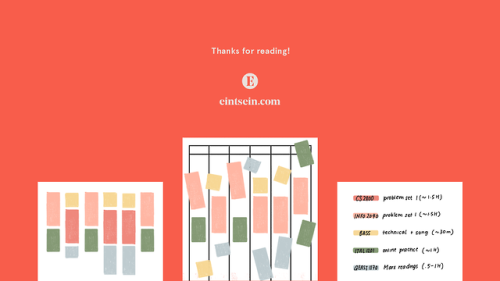
Flexible Time Blocking: A More Breathable Way to Get Things Done
I’ve met a lot of people who struggle with sticking to a schedule - myself included - so here’s one way you can get things done without restricting your spontaneity.
Linked: The ABCDE Method: Accomplish Tasks More Efficiently
Hope this helps!
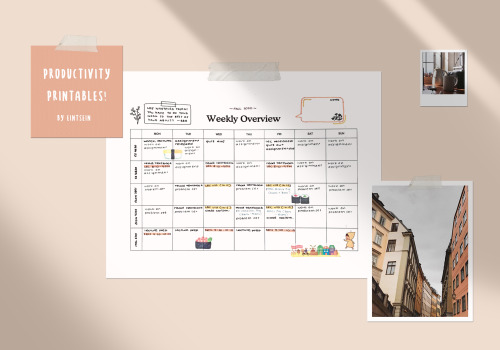
Productivity Printables
Hey everyone! The semester has kicked off for many of us already, myself included, and I just gotta say, it’s been pretty crazy. I wanted to share some tools that have helped me and hopefully can help you too in having at least some semblance of organization this semester.
A couple notes: The first preview will show both high and low contrast versions. Remaining previews will show high contrast only but there are low contrast versions available. I have no idea why but the reviews may look different on different browsers/screens. They should print out fine, though. Click images for better quality, or go straight to the download link.
Anyway, here are the printables!
Daily Printables
Daily View (High Contrast (left) | Low Contrast (right))

Attention Management (High Contrast | Low Contrast)
Energy Management (High Contrast | Low Contrast)

Weekly Printables
Weekly Overview - Monday Start
Blank (High Contrast | Low Contrast)
Task-based (High Contrast | Low Contrast)
Time-based (High Contrast | Low Contrast)
Weekly Overview - Sunday Start
Blank (High Contrast | Low Contrast)
Task-based (High Contrast | Low Contrast)
Time-based (High Contrast | Low Contrast)

Monthly Printables
Undated Monthly Overview - Monday Start (High Contrast | Low Contrast)
Undated Monthly Overview - Sunday Start (High Contrast | Low Contrast)
Misc
Einstein Matrix (High Contrast | Low Contrast)
–
Hope you enjoy them, and if you’re looking for any of my printables, they all can be found in my Study Drive. Have an awesome semester!
What a legend. Carrie Fisher is deeply missed.

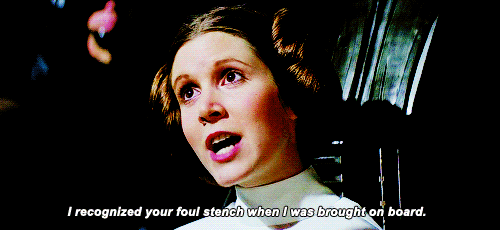
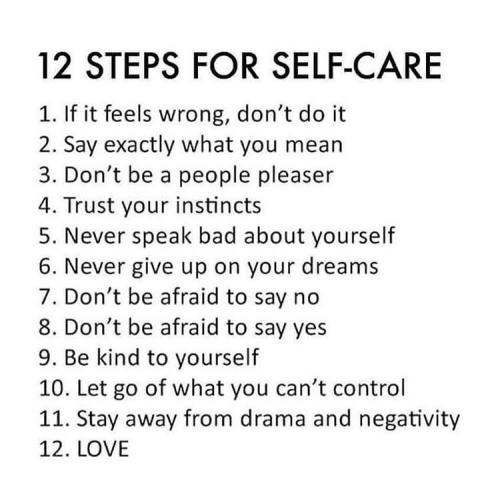
❤ More Self-Care Articles Here ❤ Share This With Your Friends Or Reblog This So You Can Read It Later
5 Ways to Achieve Your Dreams
5 Ways to Deal with an Inferiority Complex
5 Habits of Highly Successful People
5 Effective Ways You Can Self-Actualize
7 Signs You May Be Self-Actualized
7 Habits to Nurture a Positive Mindset
5 Things to Give Up to Live the Life You Want
7 Ways You Can Start Over
8 Ways to Counteract Negative Self-Talk
Make Yourself Happy
8 Ways to Take Care of Your Mental Health
7 Signs You May Be a People Pleaser
7 Ways to Stop Being a People Pleaser
10 Ways to Spot a Toxic Person in Your Life
10 Ways to Deal with Toxic People
7 Habits of Highly Successful Introverts
5 Ways Mindfulness Can Improve Your Life
5 Ways to Stop Apologizing for Everything that You Do
10 Steps for Overcoming the Need for Approval
10 Ways to Build Your Emotional Resilience
Love Yourself: Recognizing When It’s Time to Give Up
6 Ways to Deal with Inferiority Complex
5 Helpful Self Care Tips for Empaths
Healing from Repressed Anger
How Channeling Your Pain Leads to Happiness
11 Tips To Cope With Negative Thoughts
If you like to read topics about Self-Love, visit our website psych2go.net
Ψ Follow @psych2go for more Ψ

They say that a clear space makes for a clear mind. This post will provide you with organization advice for your pencil case, backpack, desk, papers, and computer to help you function at your best!
PENCIL CASE
Don’t go overboard with the stationery. From personal experience, these are the absolute essentials you need to bring in your pencil case/pouch on a daily basis:
2 black or blue pens
2 pencils
lead refills (for mechanical pencils)
sharpener (for wooden pencils)
try to get a sharpener with a locking top so the shavings won’t spill out!
eraser
2 highlighters or colored pens
calculator (if your class requires one)
And these are some non-essential but useful items:
black Sharpie
correction tape
colored pencils (useful for drawing diagrams)
mini stapler
6-inch ruler
sticky notes and page flags
if your writing utensils are expensive and you don’t want them getting stolen, maybe bring an extra cheap pencil you feel comfortable lending out
Group writing utensils together with rubber bands. Save yourself the hassle of rummaging through your entire pouch to find one particular pen. Make groups of all your similar writing utensils (ex: pencils, gel pens, felt-tip pens, highlighters, colored pencils), then tie each group together with a rubber band for easy access.
BACKPACK
Get an actual backpack. If you’re carrying more than one or two books, please please please get a normal, two-strapped backpack (and make sure to wear both straps!). Tote bags, purses, and messenger bags are terrible for your shoulders and spine.
Place the heaviest items closest to your back. Textbooks and binders should go in the largest pocket, while your cell phone, novel, pencil case, etc. should go in the front. This helps distribute the weight better and prevent back strain.
Alternate the directions of your binders to fit more. Don’t put all of your binders facing the same direction like this. Instead, alternate the direction like this– put the first binder in with the rings on the left, then flip the second binder so the rings are on the right, and so on. This also works for spiral notebooks to prevent the spirals from getting caught with one another!
I recommend keeping the following things in your bag:
pencil case
obviously, books, notes, homework, binders, and anything else required for class
planner
phone + earbuds
house keys
water bottle
granola bar and/or dollar bills to buy snacks from the vending machine
hair ties
lip balm
gum or breath mints
tissues
feminine hygiene products
travel-sized hand sanitizer/wipes
DESK
Make “to-do” and “done” piles. Each evening when I get home, I take out all the work I have to get done and put it in a “to-do” pile. This pile is usually a mixture of textbooks I have to take notes from, worksheets I have to complete, flashcards I have to review, and books I have to annotate. As I complete my work over the course of the night, I move the finished items from the “to-do” pile into a separate “done” pile. At the end of the night, I take everything out of the “done” pile and pack it into my backpack to turn in the next day. This is by no means necessary to stay organized, but I’ve found that keeping a physical representation of both what needs to be done and how much I’ve accomplished is extremely motivating.
Take advantage of vertical space. If your desktop space is limited, make use of magazine holders, caddies, and stacking letter trays to hold more papers while taking up minimal surface area.
Use cable ties and labels to manage your electrical cords. Winding up excess cord, tying it with a cable tie, and labeling it with tape will keep your desk neat, keep your mischievous pets safe, and prevent you from tripping.
Book stands are your friends. Book stands can prop up your giant textbooks and save you desktop space. They also make reading for long periods of time more comfortable, since you can look straight ahead instead of down.
Keep a trash can and recycling bin within easy reach. This is a great way to prevent paper clutter. You won’t be tempted to leave junk papers lying around if there’s a bin right next to you.
Do a seasonal deep-cleaning. Every few months or so, take everything off of your desk and do a complete overhaul. Dust off the eraser shavings from the corners. Wipe down the surface with an antibacterial wipe. Go through all of your stuff before putting it back– if you find papers you don’t need anymore or pens that have dried up, don’t put them back.
PAPERS
I personally use a 1-inch binder for every subject. I like binders because they’re durable, easily dividable/rearrangeable, and they keep papers from falling out. Separating each subject makes it super easy to grab the work I need for just one class– for example, if I want to study math at the library, I can take that one binder and go, as opposed to lugging the papers for three other subjects along with me.
Within each binder, I keep 5 dividers. The labels on the dividers vary for each class but generally they include notes, handouts, graded work, and reference materials.
If you’re looking for lighter binder alternatives: consider 2-pocket folders, accordion folders, or binder/notebook hybrids.
Keep your papers in good shape. If you’re using binders, consider splurging on either reinforced loose-leaf paper or adhesive reinforcements so you don’t end up with a bunch of papers dangling halfway out of your binder. If you have a tendency to accidentally tear your papers or spill coffee on them, you may want to scan everything into your computer as soon as you get it so you can always print out a second copy if the first one gets destroyed.
Keep a “general” folder. Get a pocket folder and fill it with extra lined, graph, and blank paper. You can also keep other general things like your schedule, a map of your school, your report card, and/or school announcements in here. Take this folder with you to every class.
Organize weekly. No matter how well-oiled your system is, you’re inevitably going to end up shoving some papers into a random pocket. Once a week, take some time to rearrange things, put papers back where they belong, and hole-punch anything your teacher didn’t.
Transfer regularly. After we finish the first unit, I always ask my teacher if I can take out my old papers and keep them at home. The vast majority of the time, the answer is yes. I transfer all my papers from completed units from my 1-inch binder to large 3-inch binders that I keep on my bookshelf. I label each topic within them with page flags for quick reference. This way I have all the resources to study for midterms/finals, but I don’t have to carry them to school every day.
Purge yearly. At the end of the school year, I recycle all of my papers. The exception is papers for subjects I’m continuing with the next year. For example, if I’m taking US History II next year, I’ll save my US History I papers because there’s a good chance I’ll need to refer to them later. If you’re not sure whether you’ll take a subject again, I’d recommend keeping the papers in the big binder just in case.
COMPUTER
Create a folder for each class. All of your files for one class should go into the same folder. If you have a big project that involves several files, you can make a project folder within a class. At the end of the school year, you may want to combine all of your class folders into a giant grade-level folder so your old files don’t clutter up your desktop.
Save your files properly. When you’re in a rush, it’s tempting to save your essay as “asdjksdfj” to the desktop, but your future self will thank you if you take ten extra seconds to give it a sensible name and save it into a class folder.
Use separate desktops for separate contexts. I have three different desktops on my laptop: school (for academic work), extracurriculars (for managing this blog and the other clubs/activities I’m involved in), and fun (for Netflix and online shopping). Keeping these three aspects of my life on separate desktops allows me to draw the line between work and play. I won’t get distracted by having Tumblr open next to my history project, and I can focus better on the task at hand when I “switch off” from one desktop and go to another. Learn how to set up separate desktops on your computer here: {Windows//Mac}.
Tag your documents. Create a tagging system to make your files easier to search for. Your tags can be by type (“essay”, “notes”) or section (“chapter 1″, “unit 8″).
Backup your devices weekly. Accidents happen, so always be prepared. Make sure to backup your computer, phone, tablet, etc. to cloud storage or an external hard drive every week. Or at the very least, get Google Photos, which will automatically backup your photos from your phone.
Thanks for reading! If you have questions, feedback, or post requests, feel free to drop me an ask.
+Click here for the rest of my original reference posts!
—Sophia :)
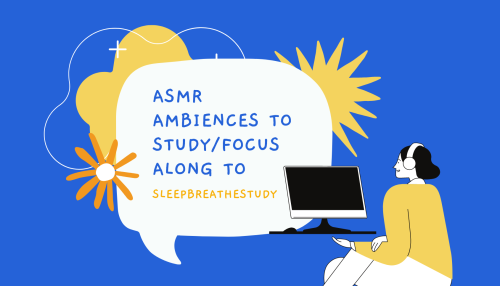
Here is a list of some YouTube ASMR ambiences/soundscapes (they’re all hyperlinked, so click away!) Unlike traditional ASMR, these videos do not feature any people. Talented YouTubers have used software to create rendered environments with layered sounds, with many of these ambiences inspired from fantasy to others based in reality. I find music with lyrics to be distracting sometimes, but these are great background noises for focusing, studying, doing homework, and even for relaxing. Enjoy and good luck ♡
LIBRARY SOUNDSCAPES
1. Royal Library | Rain and Thunderstorm Sounds on Study Ambience with Crackling Fireplace
By New Bliss
2. LIBRARY AMBIENCE: Writing Sounds, Whispering, Pages Turning, Rain, Fireplace
by Autumn Cozy
3. Ambience/ASMR: Writer’s Library from the 1930s, 4 Hours
by Ambience of Yesteryear
4. Study Ambience / Library Sounds / 3 Hours #241
By Winter Whale ASMR
5. Harry Potter inspired ASMR - Hogwarts Library REMAKE - Animated ambient soundscape cinemagraph
By ASMR rooms
CAFE SOUNDSCAPES
1. Rainy Day at Coffee Shop & Jazz Music | ASMR Ambience 4K
By Cozy Corner
2. [ASMR/Ambience]cafe after closing on a rainy urban night
By Sound Forest
3. Coffeehouse ASMR Ambience
By Miracle Forest
4. 1 Hour of Tea Shop Ambience | Background Noise | Cafe Ambient Sounds
By Nocturnal House
5. ASMR Increase Concentration Tokyo Cafe Study Ambience for Homework & School
By asmr soupe
COZY SOUNDSCAPES
1. 🎧 Cozy Ambience Bedroom - Rain on the Windows of the Rainy Night View of the City 10 Hours | Sleep
By The Relaxing Town
2. Cozy Cabin Ambience - Writer’s Room with 8 Hours of Rain, Thunder and Fire Sounds
By Calmed by Nature
3. Bed Breakfast ☕ Snowy Morning [ASMR] Cozy Cabin Ambience ❄️️ Winter Day with Little Bunny friend 🐰
By ASMR Weekly
4. Rain sounds | cozy cabin | Sleep, Study, Meditation 10 hours
By White Noise Tranquility
5. Cozy Winter Cottage | Snowstorm and Fireplace Sounds | blizzard | 10hours
By dreamy sound
INSPIRED BY SOUNDSCAPES
1. ASMR Mystical and Noble Atmosphere of Slytherin Common Room●Harry Potter 3D Ambient Sound
By asmr soupe
2. Lord of the Rings Inspired ASMR - the Green Dragon Inn - Medieval Tavern Ambience and Animations
By ASMR rooms
3. ⛩ Spirited Away’s Dormitory - 1 Hour - Ghibli ASMR Soundscape
By Vibrating Art
4. Twin Peaks Double R Diner Ambience - 8 Hours of Smooth Jazz Music, Rain Sounds, & Cozy Cafe Ambience
By Calmed by Nature
5. A Moving Castle Type ASMR Ambience
By Miracle Forest
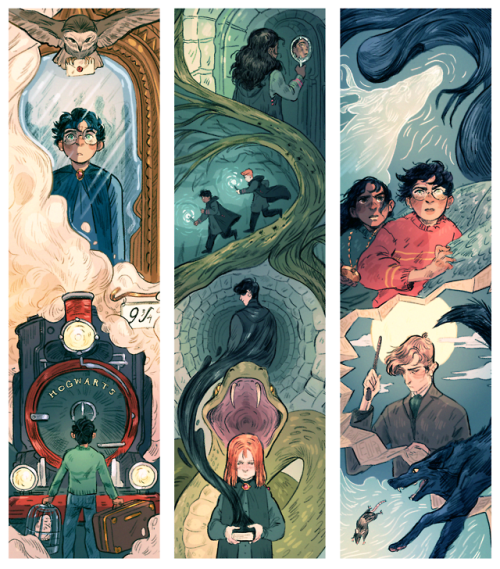
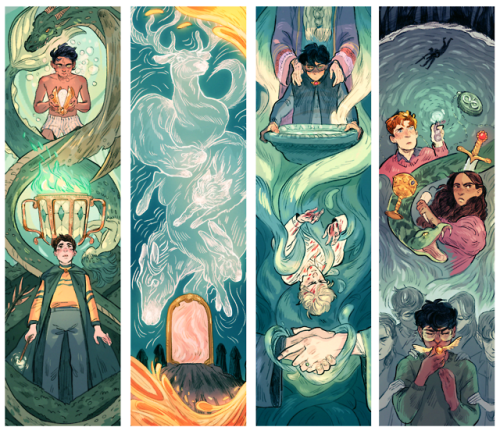
a set if hp bookmarks i’ll have for melbourne supanova next weekend! one (1) boy for each book
-
 tyrusralvez liked this · 9 months ago
tyrusralvez liked this · 9 months ago -
 stickyfrogtoy liked this · 9 months ago
stickyfrogtoy liked this · 9 months ago -
 little-greek5 liked this · 1 year ago
little-greek5 liked this · 1 year ago -
 poppypiqueerer liked this · 1 year ago
poppypiqueerer liked this · 1 year ago -
 oocooartistry liked this · 1 year ago
oocooartistry liked this · 1 year ago -
 riotictnandpegod liked this · 1 year ago
riotictnandpegod liked this · 1 year ago -
 ghostlywolfenthusiast liked this · 2 years ago
ghostlywolfenthusiast liked this · 2 years ago -
 wronskyfient reblogged this · 2 years ago
wronskyfient reblogged this · 2 years ago -
 wronskyfient liked this · 2 years ago
wronskyfient liked this · 2 years ago -
 for-the-collection liked this · 2 years ago
for-the-collection liked this · 2 years ago -
 seaf0ams reblogged this · 2 years ago
seaf0ams reblogged this · 2 years ago -
 azzysthings liked this · 3 years ago
azzysthings liked this · 3 years ago -
 boredegg liked this · 3 years ago
boredegg liked this · 3 years ago -
 starry-voidss reblogged this · 3 years ago
starry-voidss reblogged this · 3 years ago -
 starry-voidss liked this · 3 years ago
starry-voidss liked this · 3 years ago -
 raya124 liked this · 3 years ago
raya124 liked this · 3 years ago -
 scholarlyinspa reblogged this · 3 years ago
scholarlyinspa reblogged this · 3 years ago -
 skychicken36 reblogged this · 3 years ago
skychicken36 reblogged this · 3 years ago -
 notfullyhuman200 liked this · 3 years ago
notfullyhuman200 liked this · 3 years ago -
 greenstudies reblogged this · 3 years ago
greenstudies reblogged this · 3 years ago -
 red-prince-lio liked this · 3 years ago
red-prince-lio liked this · 3 years ago -
 themeadowfaery liked this · 3 years ago
themeadowfaery liked this · 3 years ago -
 bai-xin-yi liked this · 3 years ago
bai-xin-yi liked this · 3 years ago -
 paraxcosmic-jae liked this · 3 years ago
paraxcosmic-jae liked this · 3 years ago -
 canepispa liked this · 4 years ago
canepispa liked this · 4 years ago -
 callogging115 liked this · 4 years ago
callogging115 liked this · 4 years ago -
 everythingbutcalm liked this · 4 years ago
everythingbutcalm liked this · 4 years ago -
 capturingourearth reblogged this · 4 years ago
capturingourearth reblogged this · 4 years ago -
 thejamdergod liked this · 4 years ago
thejamdergod liked this · 4 years ago -
 hopeless-bisexual-queen reblogged this · 4 years ago
hopeless-bisexual-queen reblogged this · 4 years ago -
 nalyvia reblogged this · 4 years ago
nalyvia reblogged this · 4 years ago -
 nalyvia liked this · 4 years ago
nalyvia liked this · 4 years ago -
 andii2602 reblogged this · 4 years ago
andii2602 reblogged this · 4 years ago -
 andii2602 liked this · 4 years ago
andii2602 liked this · 4 years ago -
 thetomboy666 reblogged this · 4 years ago
thetomboy666 reblogged this · 4 years ago -
 thetomboy666 liked this · 4 years ago
thetomboy666 liked this · 4 years ago -
 strawbweey liked this · 4 years ago
strawbweey liked this · 4 years ago -
 aprosperlys liked this · 4 years ago
aprosperlys liked this · 4 years ago -
 chortcake liked this · 4 years ago
chortcake liked this · 4 years ago
